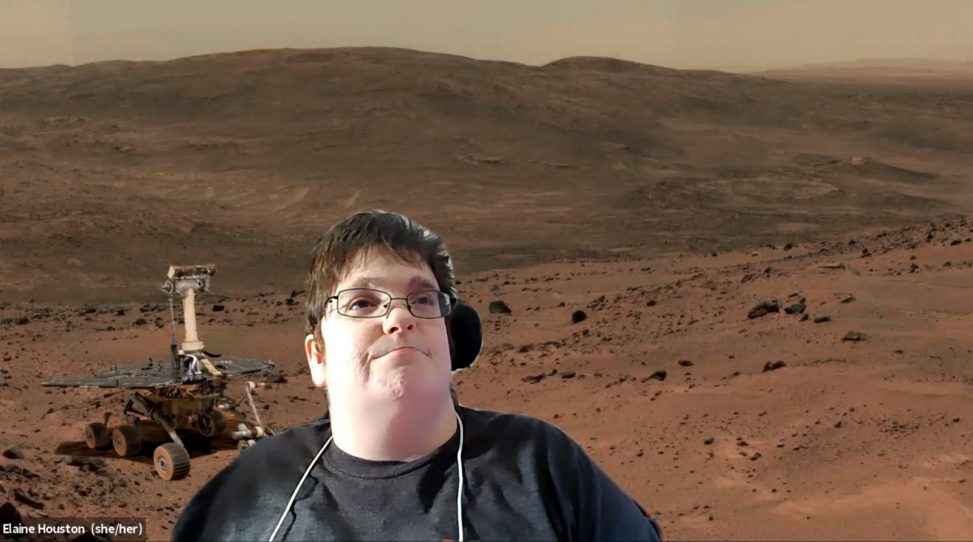Introduction
We are a student team working to design, prototype, and build a helpful assistive device for a client with limited mobility. Our client’s name is Elaine. Our design team consists of Dominique Aruede, Jud Kyle, and Eric Zhao. We plan for this to be about a six-week iterative process, including Elaine’s input every step of the way. Here, we cover the details of our first interview with Elaine from 04-06-21 where we introduce ourselves, learn more about her daily activities, and what her daily frustrations look like.
Agenda
The following was our planned course of discussion for the interview:
Intros
- Acknowledge circumstances and ask if anyone has anything they want to talk about before getting started (help warm everyone up and prepare for the interview)
- Name, background, fun fact
- Elaine
- Eric
- Jud
- Dom
- Ask for permission to record the interview
Explanation
- We are trying to prototype a useful device for you using your feedback to iterate
- We are not professional technologists, but we do want to get as close as possible to something you can use long term that is truly helpful
- Make sure to ask if they have any questions about the process
Questions
- What are some of the daily activities you enjoy?
- Why do you enjoy them?
- Is there a task or activity you like/have to do on a daily basis that is difficult or frustrating to carry out?/What is something that frustrates you when it comes to enjoying your daily activities?
- Is there anything that has become harder to do over time that you used to enjoy doing?
- Try to get to a story that they have about a particular task or daily activity if possible (Either by letting it happen naturally or just by asking)
- If possible, could you physically demonstrate a task you normally do?
- Would it be possible for you to draw your daily routine/life on a piece of paper or narrate it so that we can draw it?/Can you draw out your daily life from waking up to sleep, or you can describe it and we’ll draw.
- Trying to get a better understanding of things throughout the day that we could design something for
- Again try to get stories from Elaine
- Let’s brainstorm convenience gadgets (i.e. I would love a device that tells me when my water boils).
- Try to narrow down to a few ideas that could be pursued
Conclusion
- Thanks so much for your answers, those are all the questions we have. Our next step would be to formulate a more solid idea, and we’ll be in touch very soon to get your thoughts.
- Feel free to contact us at dominiquea@cmu.edu, judsonk@andrew.cmu.edu, and ezhao2@andrew.cmu.edu
Summary & Takeaways
The entire meeting was very fruitful, but the main takeaway was that Elaine views her service dog, Oak, as more dependable than human assistants, and therefore would love to incorporate Oak into the device in some way. We thought of several devices that that might look like. A dog-activated door opener, a dog-activated RFID card scanner, a dog-activated lifeAlert system (granted, this idea is a bit questionable for safety reasons), and finally the idea addressing what seemed to be one of Elaine’s biggest concerns, a dog-activated blinds operator; Elaine expressed that when someone leaves the blinds drawn and the room is too sunny, she can’t do anything about it on her own because she would have to pull a heavy chain which her range of motion and dexterity does not permit. So, inspired by Elaine’s suggestion that “when in doubt, think of how a squirrel might solve your issue” (only in this case we swapped out squirrels for dogs), we quite like the idea of a dog-activated blinds operator.
Team Thoughts
The meeting went a bit off the rails in terms of sticking to our actual agenda, but we got lots of pertinent information from Elaine’s comments. We definitely realized after the fact that there were things we should have clarified like what exactly do her blinds look like. A picture would have been great to figure out specifics like is it floor-to-ceiling? Is it slats that rotate or more like a canvas that rolls up? Next time, I think we’ll focus on sticking more with the agenda if the discussions starts to become derivative, although that wasn’t too much of a problem for this interview. We also would like to ask for images, videos, and other specifics if we can get them.
Talking through our ideas the next day, some of them started to make less sense for the scope of this project. For example, the lifeAlert system posed both technical and moral problems in the sense that it would be a lifeline device built by three inexperienced students, and an emergency-grade wireless connection would be difficult for use to implement. It was great to have the blinds idea stick out as the most doable assistive device, though. We are still open to pivot points, but leaning strongly toward that one.
